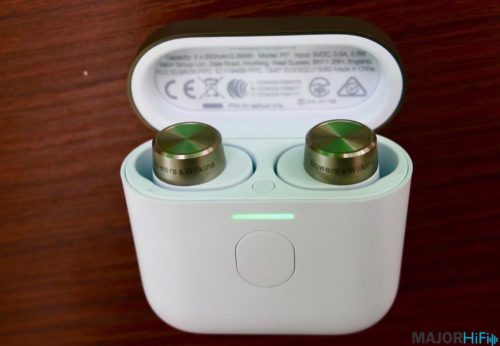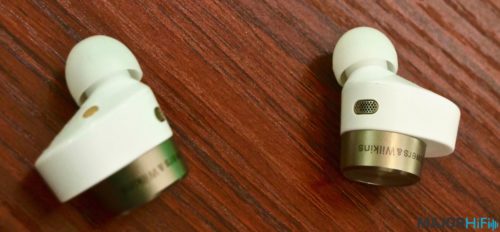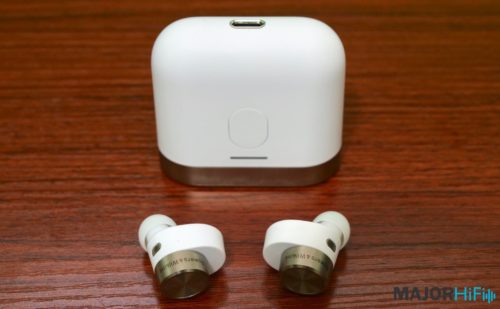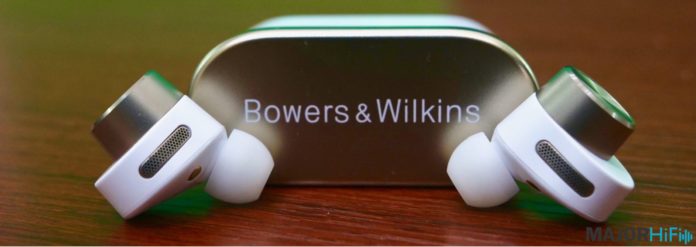Bowers & Wilkins have been making high-end headphones, earbuds, and speakers for quite some time now. In fact, I bought my first pair of higher-end headphones from them after saving up to get their C5 in my ears when I was 13 years old. They’d flown under my radar for a while, but with the launch of their new PI7 true wireless Bluetooth earbuds, Bowers & Wilkins has caught my attention yet again. These run for $399, which is at the higher end of the price spectrum for Bluetooth earbuds and tells us these cater to an audience that heavily values their sound quality. I’ve also made a video review of the PI7, which you can watch here.

Look and Feel
The goal with Bluetooth headphones seems to be to look sleek but unassuming, as to blend into the ear seamlessly. I think the PI7 does this well, the matte white body and glossy metal backing looking as modern and luxurious as you’d expect for their price point. These are plenty comfortable. I didn’t feel them rubbing up against any parts of my ear uncomfortably or starting to fall out.

Design
Bowers and Wilkins make a firm point that they are not willing to fall victim to lower quality sound with their Bluetooth headphones. The PI7 features their Qualcomm aptX™ Adaptive audio, which they claim at 420kbps matches the quality of 24bit/6kHz linear audio. This adaptive audio also features a dynamic bit rate that ensures consistent streaming quality and bit-error resilience. Moreover, the PI7 has a low-latency mode that automatically ensures optimal processing for videos and gaming.
These feature Dual Hybrid driver units with individual amplifiers, meant to help with detail and realism. We have a 9.2mm Dynamic driver for mids and bass and a balanced armature driver for the tweeter. We also get six microphones built-in for improved sound and call quality along with adaptive noise-cancelling, which monitors the audio around you and adjusts accordingly. The case is capable of wireless charging, and the headphones get 4 hours of playback time on a single charge. Alternatively, you can get one hour of playback time on a 15-minute quick charge. The total battery life is 20 hours. The case is also able to connect directly to your audio source and retransmit audio to the PI7.
In terms of the noise cancelling on these, it was a big win for me. They don’t overdo it on the pressure or “ear filling” sensation but still manage to be very effective. I didn’t even realize it was on at first until I turned it off and heard how much noise was being attenuated.

Sound signature
I found the PI7 to have an overall V-shaped sound signature. I’ve heard stronger V-shapes, but this one is definitely owning the low-end/high-end priority response. The PI7’s hard hitting, glossy response invigorated the pop music lover in me. I’ve been using “Experience” by Victoria Monet as my go to pop reference recently. It’s got a pretty intricate mix, bright high-end, punchy percussion, and texturized vocals. A lot of chances for any headphones to fly or fall. The PI7 gave a nearly flawless translation of the song, with loads of punch and detail. It seemed to rise to the challenge of what the track was requesting. The only thing I felt was missing was perhaps a bit of extra vocal presence. I didn’t have this critique, however, when I tried out the electro-kissed piano ballad “Blue Wine” by Nao. The PI7 spared not a drop of depth in the kick and bass and lifted the vocals to their fullest, translating the song with tons of cinematic atmosphere and body.
I was definitely having a 21st-century pop-centric reaction to these earbuds. They felt so clean and modern I just wanted to throw tons of synthetic soundscapes their way and let them run away with all the resonant polish. But I decided it was time to try out some older, non-electronic songs. I listened to Nancy and Lee by Nancy Sinatra and Lee Hazlewood first. I was quite impressed by how well it came across on these. I often find very clean headphones suck the life out of older recordings or warmer songs, but these breathed new life into these tracks. Outside of ultra-modern music, the PI7’s V-shape response feels less obvious and more subtly applied. They let the mixes spread out and feel picturesque and engulfing, just how they should, with some added clarity and imaging. On the front of newer music with a more organic, colored sound, I opted for some Arcade Fire. Off their album Reflektor, the PI7 did a good job of capturing the live room sound on “You Already Know” and respecting all the pleasant distortion and dissonance throughout the album.

Soundstage
The soundstage on these isn’t anything out of the left field but it’s definitely a bit above average in the world of earbuds. I found it honest to most song’s imaging and expansion. It doesn’t further widen a mix more than it already is, but if a song is a bit wider-breathed it won’t pull it in at all, instead of giving you the full immersion that was intended. The layering isn’t excessively separated, it felt more blended on some songs than others and I’ve gone back and forth on what type of imaging these really utilize. My overall impression is that they isolate a bit more than other Bluetooth earbuds I’ve heard, not to the point you’re caught off guard, but enough that you should feel satisfied in this category.
Lows
The low end response on these is major. It was the first thing I noticed when I put them in; they’re definitely used as a powerful ingredient in the sound cocktail here. I wouldn’t call the lows overpowering, as they still have a high level of clarity and control. The bass seems like it may be a big selling point for these. If you’re a bass lover they’ll be heavenly, and if you’re not, don’t say I didn’t warn you. Personally, I was impressed by how tight these were able to keep the low end even with how strong it was. I found myself running to songs I haven’t gotten the proper bass response from on headphones in a while to finally hear them the way I want.
Mids
This is a more V-shaped response, so the mids are going to be humming more than they are screaming. Not all vocals are going to get the hyper-present resonance a more prominent mid-range will give you, but they will get the extreme cleanliness a more tailored mid-range offers. The low mids retain a good amount of presence and punch, sitting considerably further forward than the high mids. How you feel about the mids on these is definitely more a matter of taste than ever. I lean towards less high mid, that’s my ears’ sore spot, so these were in my wheelhouse. If you want a sharper sound, that doesn’t seem to be the mission the PI7 is on.
Highs
Despite the high end being a fairly prominent feature on these, it’s quite comfortable. Often, a V-shape response leaves us with a lot of hiss or sibilance in the high end, and I was happy to see these avoided that almost completely. They’re fairly bright, but the slope on the high-end isn’t very plateaued and avoids boosting the more abrasive frequencies. I found the high end to be extremely clean but retaining enough subtlety to keep the PI7 overall on the warmer side, which less mid-heavy headphones often have trouble doing.

How does it compare to the PI5?
Along with the PI7, Bowers & Wilkins also released the PI5, another true wireless earbud for the lower price of $249. The PI5 looks quite similar to the PI7, but has a number of notable differences.
Technical:
The PI5 lacks the balanced armature tweeter the PI7 has in its high end, instead just having the 9.2mm dynamic drivers. Additionally, each unit on the PI7 is driven by a dedicated amplifier with a dedicated advanced DSP engine, giving it more power than the PI5 to deliver higher quality audio. The PI5 also has a lower audio resolution of 16bit, whereas the PI7 has a 24bit resolution. The true wireless sync on the PI7 is a 24-bit connection whereas the PI5 just has a true wireless plus, which is still good quality but 24bit is definitely an upgrade. We also have no retransmission ability from the case on the PI5.
These differences will matter more to some than others, to me they sound about right, like $150 worth of differences in the true wireless Bluetooth world. Both the PI5 and PI7 sport an impressive design, but the PI7 definitely earns its price point.
Sonic:
These do sound like they’re made by the same company, but they feel like somewhat distant cousins more than siblings. Their common ground is the overall warmth and punch they both share in their sound signature. However, the PI5 has considerably less bright, warmer high-end than the PI7. Both of their individual high-end responses suit different tastes, but the PI5 felt slightly less detailed in this area to me at times.
Additionally, compared to the more tame mid-range of the PI7, the PI5’s mids hold a bit more presence and weight. The high mid on the P15 is still far from sharp but is noticeably less filtered than that of the PI7. In terms of lows, the low-end on the PI5 is still prominent, I’d also call it a pretty bass-centric headphone. However, the low response on the PI7 is still more intense and sub-heavy. I concluded that the PI5 by no means sounds cheap compared to the PI7, but the PI7 inevitably holds a further tailored character given its more complex build.
You can check out our True Wireless Ranking Tool if you’d like to compare either of these earbuds to other models from Bowers & Wilkins or any other companies.

Summary
The PI7 gives its competition a run for its money in the world of true wireless earbuds. This is a challenging market to stand out in, and in terms of sound quality, the PI7 put up a good fight, conveying a substantial level of cleanliness without edging into sterility. Their heavy bass response and tamed mid-range may not be for everyone, but many will find it provides a satisfying sense of cinema and body to their listening. These are a fun, engaging pair of earbuds and reach a level of quality that keeps their price point from seeming arrogant. Bowers & Wilkins may win many over with this one.
You can purchase the Bowers & Wilkins PI7 and PI5 at Audio46
Compare the ranking of various headphones, earbuds and in-ear monitors using our tools.
Discuss this, and much more, over on our forum.
---MAJORHIFI may receive commissions from retail offers.














